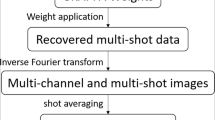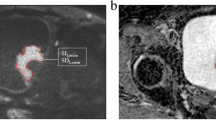Abstract
Objective
To compare geometric distortion, signal-to-noise ratio (SNR), apparent diffusion coefficient (ADC), efficacy of fat suppression and presence of artefact between monopolar (Stejskal and Tanner) and bipolar (twice-refocused, eddy-current-compensating) diffusion-weighted imaging (DWI) sequences in the abdomen and pelvis.
Materials and methods
A semiquantitative distortion index (DI) was derived from the subtraction images with b = 0 and 1,000 s/mm2 in a phantom and compared between the two sequences. Seven subjects were imaged with both sequences using four b values (0, 600, 900 and 1,050 s/mm2) and SNR, ADC for different organs and fat-to-muscle signal ratio (FMR) were compared. Image quality was evaluated by two radiologists on a 5-point scale.
Results
DI was improved in the bipolar sequence, indicating less geometric distortion. SNR was significantly lower for all tissues and b values in the bipolar images compared with the monopolar (p < 0.05), whereas FMR was not statistically different. ADC in liver, kidney and sacrum was higher in the bipolar scheme compared to the monopolar (p < 0.03), whereas in muscle it was lower (p = 0.018). Image quality scores were higher for the bipolar sequence (p ≤ 0.025).
Conclusion
Artefact reduction makes the bipolar DWI sequence preferable in abdominopelvic applications, although the trade-off in SNR may compromise ADC measurements in muscle.







Similar content being viewed by others
References
Stejskal EO, Tanner JE (1965) Spin diffusion measurements: spin echoes in the presence of time-dependent field gradient. J Chem Phys 42:288–292
Jezzard P, Barnett AS, Pierpaoli C (1998) Characterization of and correction for eddy current artifacts in echo planar diffusion imaging. Magn Reson Med 39:801–821
Koch M, Norris DG (2000) An assessment of eddy current sensitivity and correction in single-shot diffusion-weighted imaging. Phys Med Biol 45:3821–3832. doi:10.1088/0031-9155/45/12/322
Le Bihan D, Poupon C, Amadon A, Lethimonnier F (2006) Artifacts and pitfalls in diffusion MRI. J Magn Reson Imaging 24:478–488. doi:10.1002/jmri.20683
Bodammer N, Kaufmann J, Kanowski M, Tempelmann C (2003) Eddy current correction in diffusion-weighted imaging using pairs of images acquired with opposite diffusion gradient polarity. Magn Reson Med 51:188–193. doi:10.1002/mrm.10690
Kartalis N, Lindholm TL, Aspelin P, Permert J, Albiin N (2009) Diffusion-weighted magnetic resonance imaging of pancreas tumours. Eur Radiol 19:1981–1990. doi:10.1007/s00330-009-1384-8
Sugita R, Yamazaki T, Furuta A, Itoh K, Fujita N, Takahashi S (2009) High b-value diffusion-weighted MRI for detecting gallbladder carcinoma: preliminary study and results. Eur Radiol 19:1794–1798. doi:10.1007/s00330-009-1322-9
Koh DM, Scurr E, Collins D et al (2007) Predicting response of colorectal hepatic metastasis: value of pretreatment apparent diffusion coefficients. AJR Am J Roentgenol 188:1001–1008. doi:10.2214/AJR.06.0601
Vandecaveye V, Dirix P, De Keyzer F et al (2010) Predictive value of diffusion-weighted magnetic resonance imaging during chemoradiotherapy for head and neck squamous cell carcinoma. Eur Radiol. doi:10.1007/s00330-010-1734-6
Alexander AL, Tsuruda JS, Parker DL (1997) Elimination of eddy current artifacts in diffusion-weighted echo-planar images: the use of bipolar gradients. Magn Reson Med 38:1016–1021
Reese TG, Heid O, Weisskoff RM, Wedeen VJ (2003) Reduction of eddy-current-induced distortion in diffusion MRI using a twice-refocused spin echo. Magn Reson Med 49:177–182. doi:10.1002/mrm.10308
Steidle G, Schick P (2006) Echoplanar diffusion tensor imaging of the lower leg musculature using eddy current nulled stimulated echo preparation. Magn Reson Med 55:541–548. doi:10.1002/mrm.20780
Finsterbusch J (2009) Eddy-current compensated diffusion weighting with a single refocusing RF pulse. Magn Reson Med 61:748–754. doi:10.1002/mrm.21899
Padhani AR, Liu G, Koh DM et al (2009) Diffusion-weighted magnetic resonance imaging as a cancer biomarker: consensus and recommendations. Neoplasia 11:102–125. doi:10.1593/neo.81328
Delakis I, Petala K, De Wilde JP (2005) MRI receiver frequency response as a contributor to Nyquist ghosting in echo planar imaging. J Magn Reson Imaging 22:324–328. doi:10.1002/jmri.20365
Jahng G, Weiner MW, Schuff N (2008) Diffusion anisotropy indexes are sensitive to selecting the EPI readout-encoding bandwidth at high-field MRI. Magn Reson Med 26:676–682. doi:10.1016/j.mri.2008.01.005
Buonocore MH, Gao L (1997) Ghost artifact reduction for echo planar imaging using image phase correction. Magn Reson Med 38:89–100
Yoshikawa T, Kawamitsu H, Mitchell DG et al (2006) ADC measurement of abdominal organs and lesions using parallel imaging technique. AJR Am J Roentgenol 187:1521–1530. doi:10.2214/AJR.05.0778
Braithwaite AC, Dale BM, Boll DT, Merkle EM (2009) Short- and midterm reproducibility of apparent diffusion coefficient measurements at 3.0-T diffusion-weighted imaging of the abdomen. Radiology 250:459–465. doi:10.1148/radiol.2502080849
Kandpal H, Sharma R, Madhusudhan KS, Kapoor KS (2009) Respiratory-triggered versus breath-hold diffusion-weighted MRI of liver lesions: comparison of image quality and apparent diffusion coefficient values. AJR Am J Roentgenol 192:915–922. doi:10.2214/AJR.08.1260
Dale BM, Braithwaite AC, Boll DT, Merkle EM (2010) Field strength and diffusion encoding technique affect the apparent diffusion coefficient measurements in diffusion-weighted imaging of the abdomen. Invest Radiol 45:104–108. doi:10.1097/RLI.0b013e3181c8ceac
Heverhagen JT (2007) Noise measurement and estimation in MR imaging experiments. Radiology 245:638–639. doi:10.1148/radiol.2453062151
Acknowledgements
We acknowledge funding from: EC FP6 Marie Curie Action, Molecular Imaging for Translational Research Applications in Cancer, contract 020718; Cancer Research UK and ESPRC Cancer Imaging Centre in association with MRC and Department of Health (England), grant C1060/A10334; NHS funding to NIHR Biomedical Research.
Author information
Authors and Affiliations
Corresponding author
Rights and permissions
About this article
Cite this article
Kyriazi, S., Blackledge, M., Collins, D.J. et al. Optimising diffusion-weighted imaging in the abdomen and pelvis: comparison of image quality between monopolar and bipolar single-shot spin-echo echo-planar sequences. Eur Radiol 20, 2422–2431 (2010). https://doi.org/10.1007/s00330-010-1826-3
Received:
Accepted:
Published:
Issue Date:
DOI: https://doi.org/10.1007/s00330-010-1826-3




